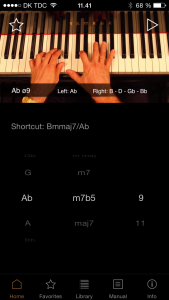How to use the app
- Choose the chord root in the left pull-down
- Choose the chord type in the middle pull-down
- Choose chord extensions in the right pull-down
Note: chordroot Db=C#, Eb=D#, Gb=F#, Ab=G# and Bb=A#
Note: the chord 7, 9, #11, 13 is often written as 13, #11
Note: the chord dim 13 shall be read as dim b13.
Note: the chord m7b5 11- dominant grip – has no 9.
Note: b13 = #5
Once you have chosen a chord you can stream it or save it under Favourites. If you hide the chords under Favourites, you can use the app even if there is no net connection or Wi-Fi.
The dominantgrip or the grip
Except for the root many jazz chords consist of the notes you will find in an extended dominant chord. Example: the upper four notes in G13 are F-A-B-E. When you play these four alone without a root in your left hand you are playing what is called the dominant grip (or the grip). The four notes are the notes of an F∆ #11 and can of course be inverted.
Why is the chord called a dominant grip?
The four notes sound like a dominant due to the triton interval between F and B. If you play these four notes (F-A-B-E) in your right hand and play the chord roots G, B, C#, D, E and F, you will hear these very common jazz chords from the D minor melodic scale:
G 13
Bm7b5 omit 3
C#7 #9, b13
Dm 6/9
E7sus b9 omit 7
Fmaj #11
This means that 7 chords, m7b5 chords, m6/9 chords, 7sus b9 chords and ∆ #11 chords can be played with a dominant grip in your right hand.
In Shortcuts I have written Dominant Grip, when I play the dominant grip.
How to play a dominant grip?
The dominant grip is easy to find. Play a ∆-chord in root position and lower the fifth. Example: play a F∆ and lower the fifth C to B, and now you have the dominant grip. The dominant grip can of course be inverted.
You will find the matching minor melodic scale a minor third below the lowest note in the dominant grip. Example: dominant grip Bb-D-E-A. The matching minor melodic scale is G.
So What chord
A So What chord (named after the chord used in the Miles Davies composition “So What”) is a minor 11 omit 9 chord. This chord is special due to its structure. From the root and upwards it consists of three perfect fourth intervals with a major third interval on the top. Example: the notes in a Dm11 chord played as a “So What” chord are D – G – C – F – A.
In Shortcuts I have written “So What”, when I play a “So What” chord.
m7 b5 chord
The m7 b5 chord can also be written as ø. Example: Cm7 b5 = Cø.
Diminished chord
The diminished chord written as dim. can also be written as o7. Example: Cdim. = Co7
About Shortcuts
In shortcuts you can see this chord type: Ab sus C7 omit 5.
This means that you play an Ab sus chord on top of a C7 omit 5 chord.
